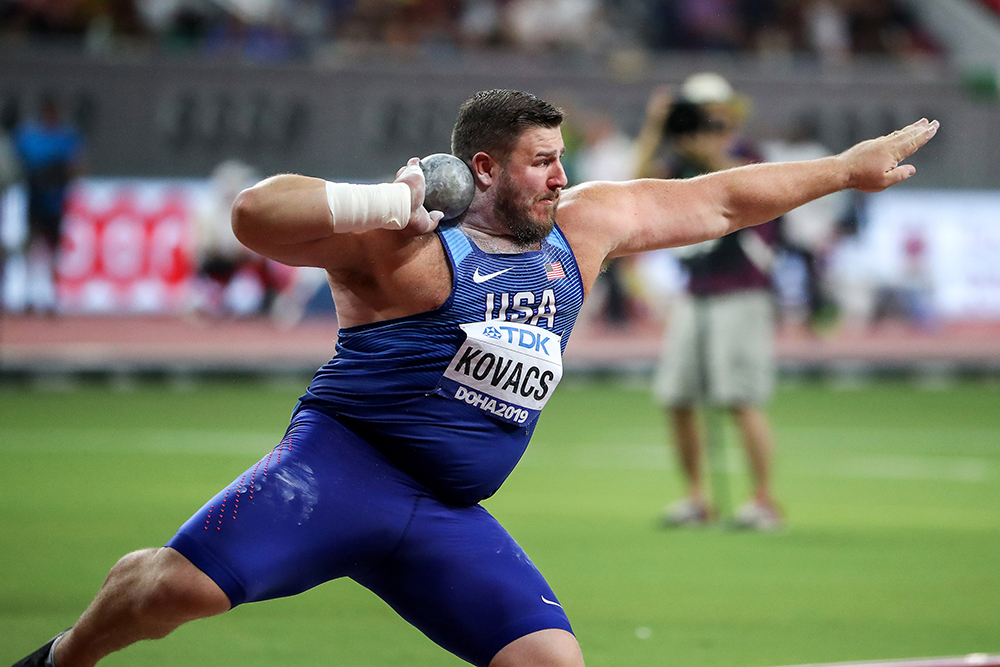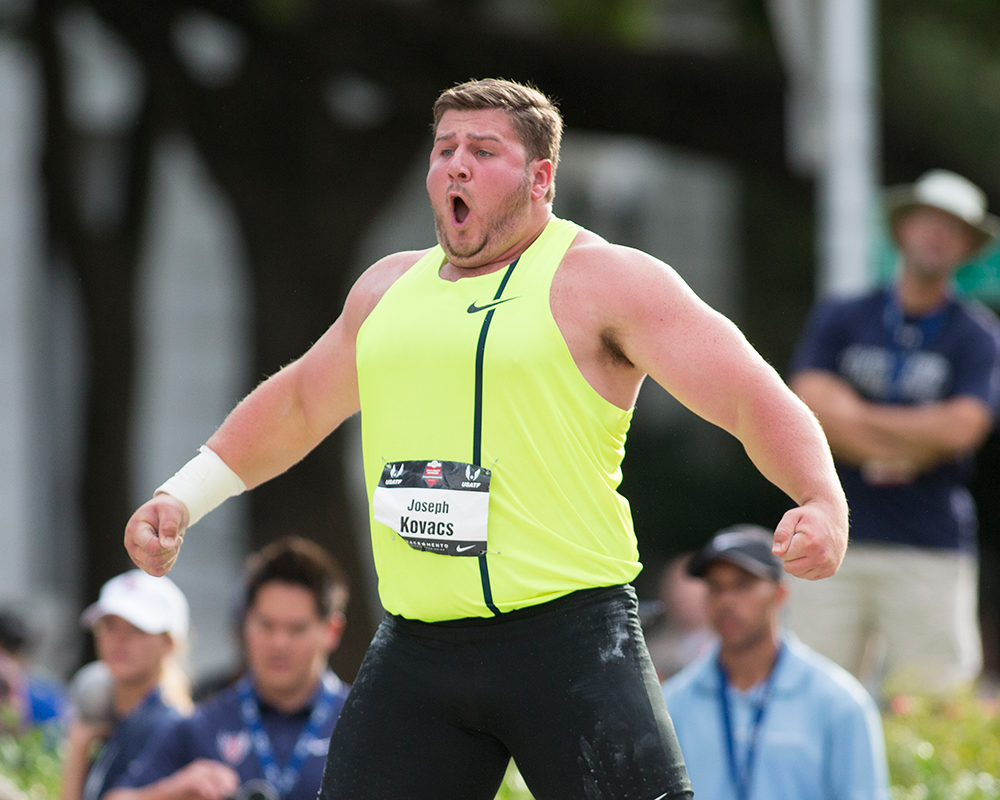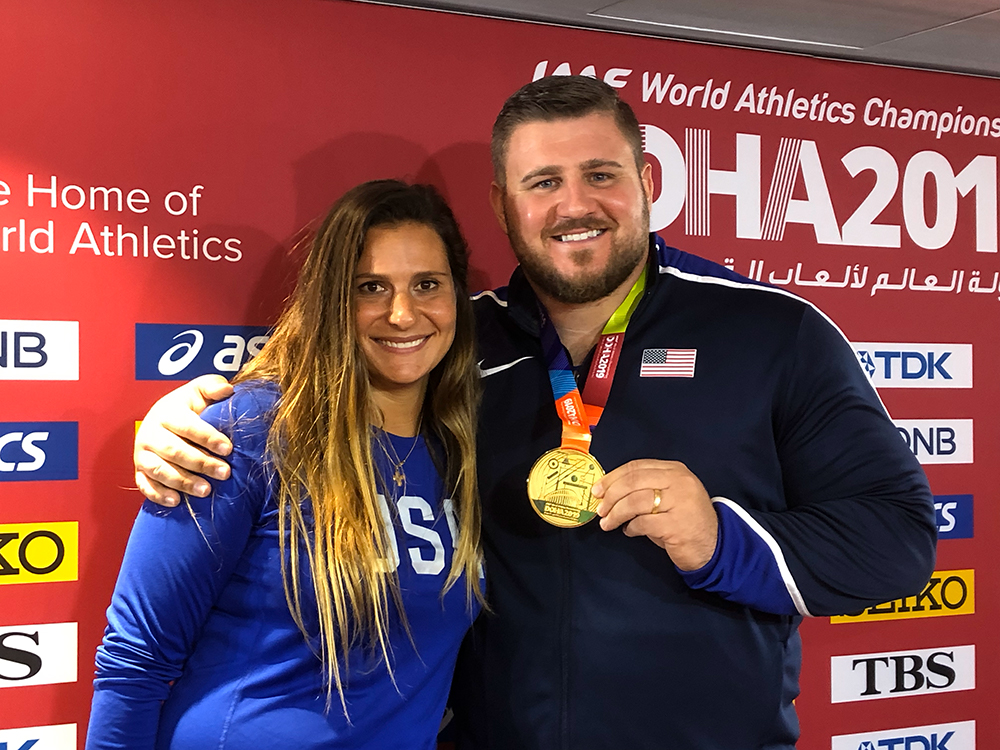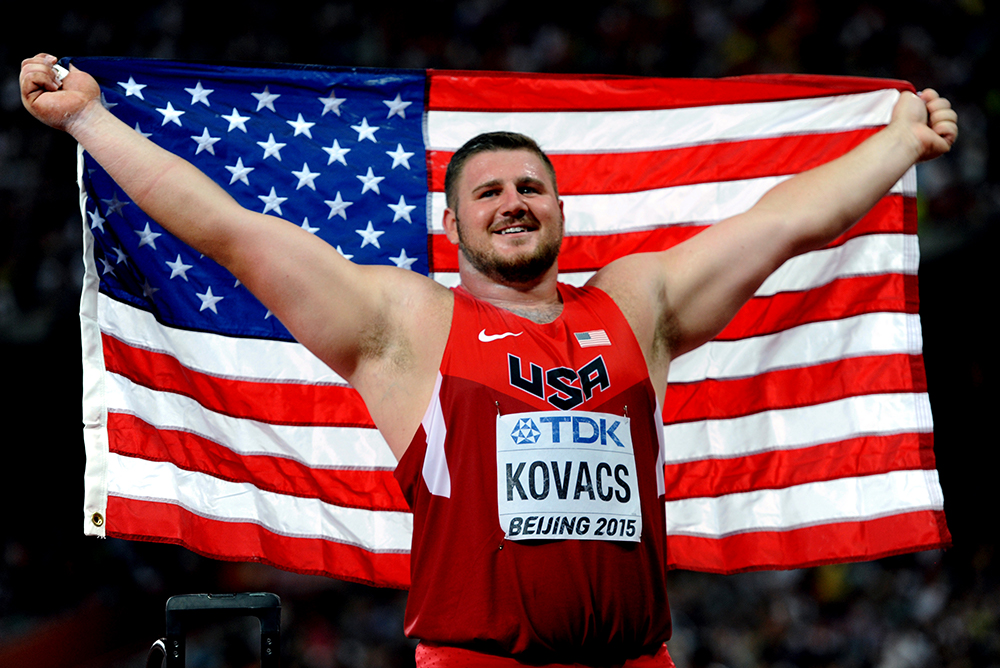
WHAT’S HAPPENING ON THE FIELD when an event’s stars align at a championships to compete at a level never seen before? Doha World Championships men’s shot, we’re talking about you here.
Joe Kovacs, the winner of that magical comp, the first ever with three men over 75-feet, opened his outdoor campaign this year throwing bombs at the Jesse Owens Classic. As he looks toward Tokyo and the Olympic Trials he needs to compete through successfully to get to the Games, he’ll tell you what he feels he learned in Doha.
Make that what Kovacs, who will turn 32 in June, has learned earning two Worlds golds and an Olympic silver at Rio 2016. And before and after that.
“I think it’s not just Doha,” says the Penn State alum. “I think it’s all the way back from 2012, when I got 4th at the Olympic Trials, to making the team in ’16, winning [the world title] in ’15 and making the team in ’17. It’s just, I have to start kind of relying on my veteran résumé now. I’m not — I don’t want to call it nervous — I don’t think I could replicate how I started in 2012 and ’13, ’14. I went into those meets with so much intensity because so much had to be right for me to have the possibility of being on the team.
“I think I’m trying to approach [this summer] with more of a veteran mentality of, ‘My numbers are there, my body’s there, let’s go execute,’ just kinda check all the boxes. Because when that happens, honestly, it’s a lot easier.
“I probably got a little frantic and panicky in my past because when one thing was off, it felt like everything was wrong. But I think my new awareness for the throw and technique gives me a lot more confidence going into these major competitions that it’s not this head-to-head battle.
“It’s such a different sport for me when I compare my 2015 World Championship, when it was really me vs. David Storl. I mean, there were a lot of other good guys at that time, but it was ultimately who was going to win. It was me vs. him. And I think everybody knew that at that point.
“At this point, the level is so high. It’s like, I only need to worry about myself. I don’t really care what Ryan [Crouser] does. If he wants to throw the Record, I’ll throw the Record eventually after him, you know. It’s going to go back and forth, but I’m not trying to get into these head-to-head battles that are counterproductive.
“I think when that 2015 [WC] meet was a head-to-head competition, that intensity and that mindset made it exciting for me to really go hard. But going hard doesn’t win you championships anymore. Everything has to be right.
“When Tom Walsh on his first throw threw 75-feet — farther than any of us have ever seen in our lives in competition —then it’s not like, ‘Hey, I can’t wait to beat Tom at this competition in Doha.’ It’s like, ‘I have to do every single thing perfect to be able to pull this off.’
“I believe that Tom thinks the same way. Ryan thinks the same way. Everybody starts to think that it’s not this battle. Obviously, the battle and the energy is exciting for the fans and exciting for us going into it, but we need to all kind of execute everything at the highest level, because honestly that’s how far we’re throwing at this point. It has to be.”
Pure performance. Cool concept. We fans hanging on every throw can add whatever storyline we like.
Kovacs comes to this analysis and the clashes ahead more prepared than he has ever been before. He has numerical evidence though Kovacs and his wife/coach Ashley have a nuanced view about the digits even as they’ve occasionally social-media-showcased video of some boggling workouts.
Like a 4 x 870lb (c396kg) squat set in April.
“My whole body strength-wise is probably at least 10 to 15% stronger than I’ve been in my past,” Kovacs says. “In tons of ways; my bench is up a lot. But I think it’s like everybody wants to get caught up in the numbers, but we talk about managing hits and managing efforts. So the number is relative and then it gives us a good gauge of where I was in my past to where I’m going, but we’re really just trying to push my exertion.
“Whatever that day’s best is going to be, that’s where that number falls. And that’s how we can kind of get to a good recovery away from it too.
“So the numbers are great, to see them go up, but also I think more than anything, I’m happy that I can start walking away from these numbers and have good training a week away from that. That squat took a little bit longer than a week, but we planned for all these, the recovery from it. I think that’s given me more confidence because I’m actually able to kind of be coherent throwing now and it’s a lot more relaxing to practice because of it.”

In the ring, of course Kovacs was happy to open outdoors with 74-6½ (22.72), the second-longest throw of his career, but again he has a refined view of the numbers, focused like a laser by Ashley, who coaches Ohio State’s throwers in her day job. Data analysis is her wheelhouse. It often starts when Joe opens his eyes in the morning. More on that later.
“I think for me the big thing that we never talked about, we’re really managing my body I think better than I ever have in my life,” Kovacs says. “And I think because of that every single record I could have throwing with the different implements, every single number in the weightroom, they’ve all been my best this year. So it gives me the confidence.”
All of Kovacs’ metrics are up, “even including my indoor PR, which I did one meet indoors just to, why not? I finally threw over 22 [c72ft] indoors — but that’s an indoor PR for me.”
One wonders, what’s the fountainhead of the 2021 fitness Kovacs’ describes? That careful body management? A technical advance?
“I think both,” he says. “I think my technique has changed since working with Ashley in the beginning of 2019 through the World Championships. And then I would say I finally am throwing how I probably should have always been since this past fall. Obviously I didn’t have any huge problems, but I think there were things I did on big throws that I didn’t continually train on. You know, they happened when I felt good because I was moving well and now she was able to point out to me all those things that happen when I do throw well.
“And it’s kinda like, ‘Well, why don’t we just train those things more often and become better at those?’ So I think I’ve kind of really fine-tuned the feel of throwing. It sounds crazy to say at this stage in my career that I’m like maybe relearning how to throw, but I’ve become so much more relaxed and consistent in training.
“I used to have very volatile training. Especially when I was in California, it was 4m [13ft] swings in between what it could be just because of some of the technique things and my body issues. And now I can almost hit the same mark every single day. It’s pretty consistent.
“I graphed out an Excel sheet. You know, there’s a conversion if you’re throwing different size implements; it’s about 2½ft [75cm] per pound. So I’m always trying to keep whatever implement I’m throwing at that relative level. You know, if I’m trying to be in 70-foot [21.34] shape or 75-foot [22.86] shape, a 14-pound [6.36kg] should be going about 5ft [1.52m] farther than 70ft. So if a 14-pound ball goes 75ft, then that’s 70-foot shape, and then same thing for an 18-pound [8.18kg] ball, 2lb the other way.
“So I’m trying to keep myself accountable to have every single ball, every single implement and every time I do it never drop off and always be in that kind of sweet spot so that I know within 2 weeks or 2 days if there’s a competition, I’ll be ready for it.”
Ready for it, Kovacs says, through his amazing collaboration with Ashley.
Kovacs accords his former coach Art Venegas superlative esteem. But after Kovacs relocated to Ohio following his heart to Ashley after the ’18 season and commenced working with Venegas at a geographical distance, he says, “It got pretty rough at the end just because Art’s such a good presence in person. It just wasn’t the same. I wasn’t holding myself to the same standards.”
Read more on the backstory of Kovacs’s coaching switch here.
Preparing with Ashley as his mentor for the last two years has Kovacs stoked for the summer ahead. “She loves performance,” he says, “from the mental side to the physical side, and tracking things. Her passion is tracking performance and optimization. So, I mean, I was dumb to not utilize that from the start, but since that’s happened everything’s just gotten so much more fine-tuned.
“Then obviously it paid off in 2019 at the end winning the Worlds. But I think I’m more happy about this training, my fall and winter season, than I even was going into Doha just because everything’s trending so much higher and it’s tracking so well.
“Having her as a coach, I mean, it is definitely weird and unique in most people’s scenarios, but the way it started, I needed her and now I still need her more because I’m doing better than I’ve ever done in my whole career.

“I’m more locked in and she gets to see me more than any coach would ever see me. So when she sees me wake up and my eyes are a little bit more glassy than was expected, she can audible that day’s workout before it even happens, before I even get to the track. Like she’s always kind of tracking me and setting up the success we need to have. Because there’s no need to push through a bad day because that ruins the rest of the week. We’re able to kind of make good adjustments and I’m able to trust her in doing that.
“Honestly, in Doha one of the reasons I think I did so well in that final is she stopped me from a practice, two practices, I would normally have before going into a World Championships. She saw I was kind of flopping around and my central nervous system was just tired and down and I threw way less the week before the World Championships. I think I was just that much fresher and I think if that little bit of freshness allowed that one extra centimeter, I’m pretty damn happy that she made that call.”
It’s safe to guess only Ashley has an eye for Joe like Ashley does. But that central nervous system comment has gifted coach written all over it.
Says Kovacs, “I think every coach — even, I would say old school, back then they had a good knowledge of muscle recovery — but the muscle recovery’s not a big deal for me. I’m a very central-nervous-system-driven athlete. When that’s down, I start protecting myself and tightening up. Which is a good problem because I’ve never had any major injuries, but when I get in protection mode the technique suffers. There’s no range, I can’t get any of that relaxation. And then essentially it’s a wasted day of practice when I’m in that mode.
“So Ashley is able to track my central nervous system, she’s able to track that part. And I think that’s where I’m able to fine-tune my practices so much better now in terms of technique and then also just execution of numbers.”
Wife/coach’s eyes, intuition and execution aside, Team Kovacs called a competition audible in September of pandemic ’20 when they traveled to Europe for two meets and willingly stepped in front of the shot freight train that was Crouser last year — and as Crouser continues to be.
As Crouser spun out bombs at will above 74ft (in the mid-22s metrically) in Zagreb and Belgrade 3 days apart, Kovacs boldly faced him with meet bests of 69-10¾ (21.30) and 67-7½ (20.61).
“It was one of those weird scenarios, ’cause I thought there was absolutely going to be nothing,” says Kovacs, describing a late summer that won’t make anybody’s top 10. “I think we thought literally nothing was going to happen the whole year. And it almost seemed crazy that there was going to be any competitions.

“But then I saw Ryan was going over and I got a call. It was a Tuesday and it was like, ‘Hey, you want to come to a meet on Saturday?’ It was that Polish meet Ryan went to. I was barely starting to train then, I was still throwing at a middle school. We were still quarantined and shut down here so I was just starting up training, but you know, at that point I felt like I needed to kind of start my fall training mindset.
“So I’m really glad we went over there just to hop in those meets. I mean, the first meet went OK considering I was barely training at that point and the second was a little rough, but it was my wife’s birthday the day before. So I was probably out a little too late taking her to dinner, but you know, I really am glad that I went to those meets.
“I mean, I wasn’t surprised what Ryan was doing ’cause I think he had a plan. He knew what was happening probably 2, 3 months before I knew it was happening. So I wasn’t surprised at what he was doing at all.
‘I’m glad I went over there because when I came back, I came back to my fall training kind of sparked up just with the mentality of like, ‘OK, let’s keep going.’ That’s really what started my training in the fall, just going to those meets.
“And also we had a good time over there when we got done. I took Ashley back to Croatia after that Belgrade meet and we spent a couple of days in the islands, so that was pretty nice.”
While Kovacs has at least a couple more meets planned next week, the Tucson Elite Classic (May 20) followed by the USATF Throws Festival in the same ring two days later, the Olympic Trials naturally are the mid-term focus.
Raise your hand, U.S. shot fans, if you’re not on the same page. Knew you would be.
“There is way more pressure on the Trials than there is the Olympics and that’s just how it is,” Kovacs says, “so preparation-wise to have that minimum level ready at the Trials just to make sure you punch that ticket.
“I mean, I’d love to say that my consistency and Ryan’s consistency, and maybe even you could throw Darrell [Hill] in there, should be able to make that day easy, but it never is. And because of that, it’s just getting through that day.
“We’re throwing all in one day where it’s the first day of the Trials on June 18th. So we do a morning qualifier and the afternoon final — which I’m not really sure why they’re doing that because it’s not like that in the Olympics anymore, or the World Championships. It’s split up.
“I’ve already done morning and afternoon so I’m not really nervous about doing it. But I think for some of the younger athletes, they’re going to be a little shocked that they have to come back afterwards and manage that. But, you know, it shouldn’t be that hard in the morning to then get a throw out there in the evening.”
Come that 6:30pm first OT final, let it reign. That’s not a typo for “rain.” We hope.
Says Kovacs, “I think once one of us punches our ticket in the sense that we know a 22-mid throw statistically should put us on the team,” once that launch button is pushed, “I think it’s going to seek who has fun out there and puts out a big throw. Because I know we’re all going to be physically and mentally ready for that meet, and then probably even more locked in than we will be going into Tokyo just because of what’s at stake.”